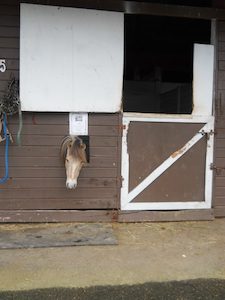Four Important Bio-Security Practices for Stable Management
by R. Paul Schwab, DVM

I like to compare bringing a new horse into a stable to the new kid coming into a preschool or kindergarten class: At some point there is going to be some snotty noses. This is especially true when you add in the stress of a horse show, travel in a small trailer, and several nights in a stall. There are a few steps you can take to try to reduce the chances of a farm-wide disease outbreak.
Quarantine
If at all possible, a separate area of the farm should be available to be used as a quarantine pen. New horses should stay in this pen for three weeks. They can be monitored for signs of coughing, fever, snotty noses, etc. Ideally, this pen should be handled last so that any possible infection won’t be transmitted to the “clean” horses by farm staff. In some circumstances it may be wise to have coveralls and boots dedicated to the quarantine pen to prevent cross contamination. Boot and hand wash stations can be particularly useful.
Disinfection
The choice of disinfectant is very important. Chlorine bleach has always been the gold standard for disinfection, but it does have some very important limitations in a large animal setting. Bleach is easily de-activated in the presence of organic material. This means it only really works on already clean inanimate objects made of plastic, steel, or nylon (brushes, nylon halters, buckets, etc.). If there is any dirt, manure, or wood, bleach doesn’t work well. Oxidizing disinfectants such as Trifectant™ and Virkon-S™ may be a better choice in a barn situation with wood, although thorough cleaning before disinfection is always recommended. These disinfectants are also stable after mixing for 5-7 days, making them a good choice for boot wash stations.
Strangles PCR Screening
The disease that seems to be one of the worst for bringing onto a farm is streptococcus equi better known as “strangles.” Strangles comes into a farm from carrier horses or horses that have had a recent infection and are still shedding. Fortunately, there is a PCR (polymerase chain reaction) test that can pick up minute particles of the bacteria that the horse has in its upper respiratory system. The test is fairly simple and involves flushing saline into the nasopharynx (back of the nose/throat) and collecting the fluid that comes out the nostrils. That fluid is tested at a lab and within 3-5 days you will know if the horse is carrying or shedding the strangles bacteria. This test can also be useful for testing horses that have had strangles to determine when they can be transported or put back with the herd.
Vaccination
Vaccination is always an important part of bio-security. For the new horse, vaccinating two to three weeks before arrival to a new farm is ideal. It will help protect the new horse from the bacteria and viruses at the new farm. A good vaccine program at the farm will help protect the herd from the new arrivals. It’s important to talk to your veterinarian about what vaccines are needed or recommended for your farm and the type of horses coming into your barn.
Pre-planning for a disease outbreak is an important part of stable management. It takes good communication and teamwork between the stable owner, boarders, trainers, and veterinarians so that outbreaks are contained and hopefully prevented altogether. Discuss with your veterinarian your bio-security/disease prevention plan.
Originally Published September 2014 Issue

The Northwest Horse Source is an independently owned and operated print and online magazine for horse owners and enthusiasts of all breeds and disciplines in the Pacific Northwest. Our contemporary editorial columns are predominantly written by experts in the region, covering the care, training, keeping and enjoyment of horses, with an eye to the specific concerns in our region.






